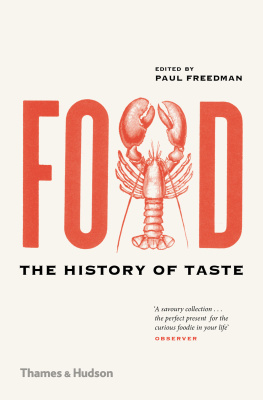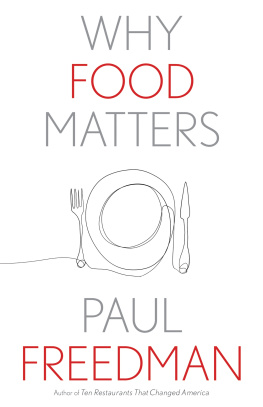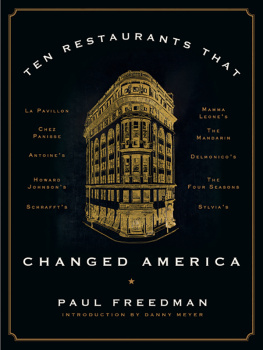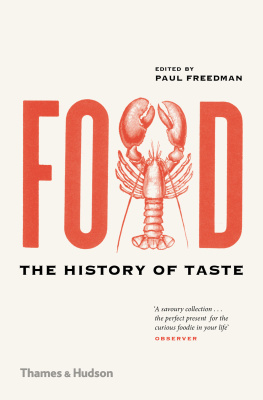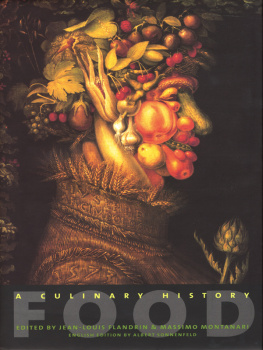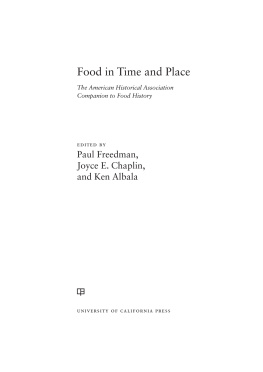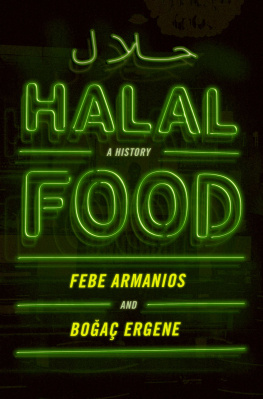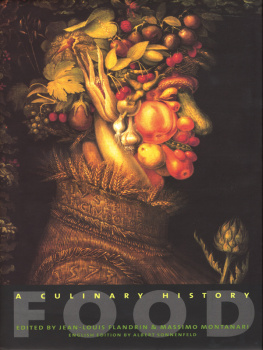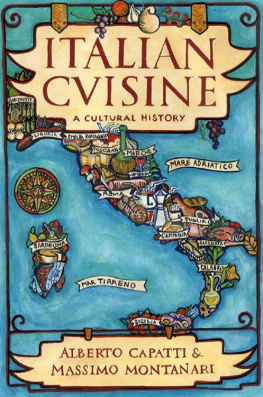

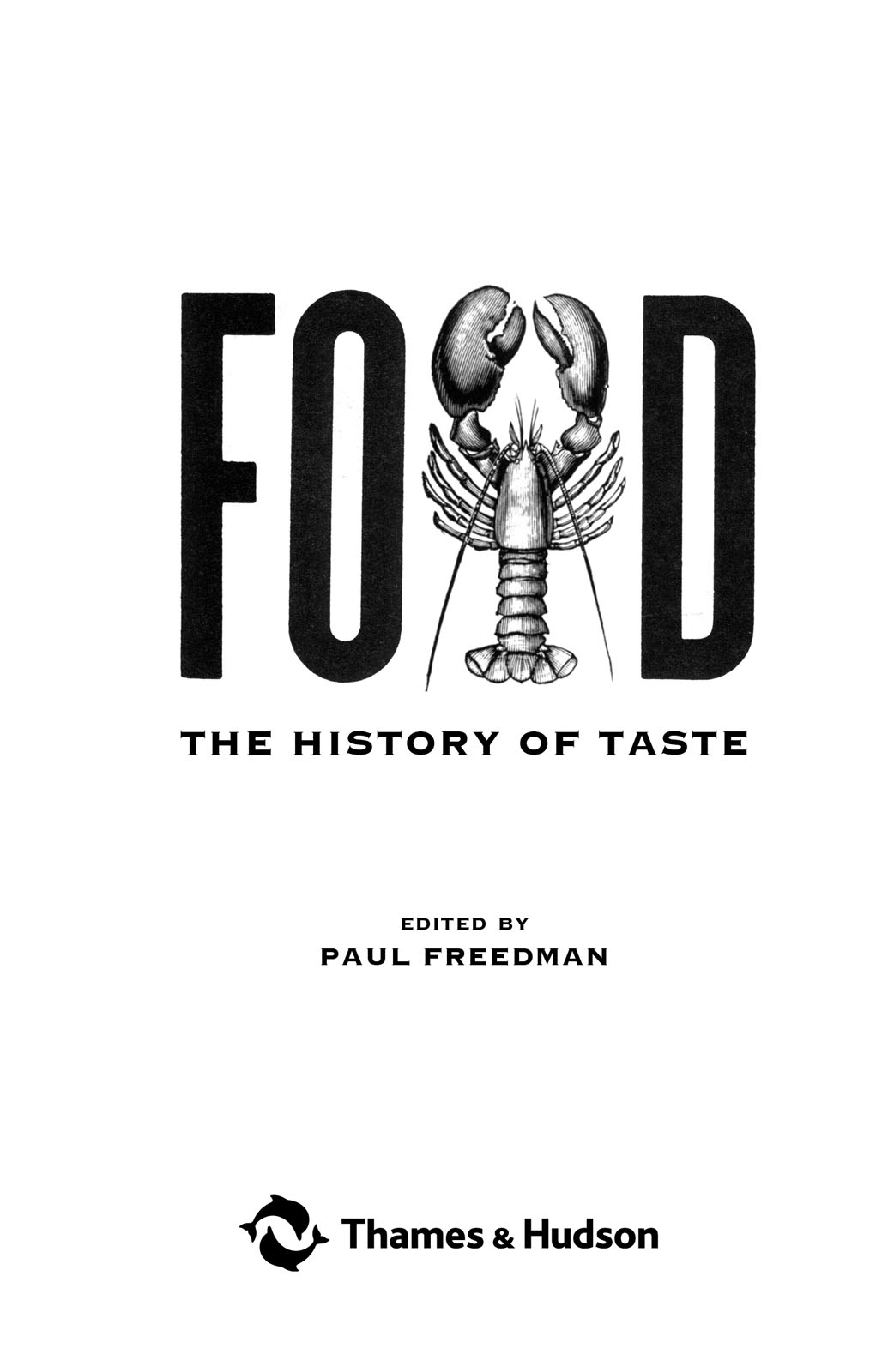
About the Author
Paul Freedman is Chester D. Tripp Professor of History at Yale University and former Chairman of the Department of History there. His other works on food include Out of the East: Spices and the Medieval Imagination (2008) and, as co-editor, Food in Time and Place (2014). For many decades he has sought out and found fine food and dining experiences in many countries.
Other titles of interest published by
Thames & Hudson include:
An Anarchy of Chillies
Herbarium
The Grammar of Spice
The True History of Chocolate
See our websites
www.thamesandhudson.com
CONTENTS
A New History of Cuisine PAUL FREEDMAN
The Evolution of Taste in Prehistory ALAN K. OUTRAM
Tastes of Ancient Greece and Rome VERONKIA GRIMM
Taste and Gastronomy in Imperial China JOANNA WALEY-COHEN
The Birth of Medieval Islamic Cuisine H.D. MILLER
Food and Taste in Europe in the Middle Ages C. M. WOOLGAR
Food Fashions after the Renaissance BRIAN COWAN
Food Innovations from 1800 HANS J. TEUTEBERG
French Cuisine in the 19th and 20th Centuries ALAIN DROUARD
The Development of the Restaurant ELLIOTT SHORE
The New Landscape for Gastronomy PETER SCHOLLIERS
A New History of Cuisine
PAUL FREEDMAN
Taste is not simply the preserve of a tiny aristocracy of the court culture of the European, Abbasid or Chinese past or the foodie cutting-edge of the present In the social history of ordinary people, caloric intake, the threat of famine and the supply of urban centres are among the topics that have given us an idea of the fragility and difficulty of pre-industrial life. The relevance of the history of food in its most basic sense needs no justification. The exchange of products resulting from the discovery of the New World, the dependence of societies on one overwhelmingly important food source (as with nineteenth-century Ireland and the potato), or the impact of modern warfare on civilian diet are all major topics. In the mid-twentieth century, historians interest in the conditions of society, and particularly the history of ordinary people, inevitably involved questions of how peasants or workers lived in the past; how well or ill-nourished they were; how they coped with unpredictable harvests, food supply and prices.
In contrast, accounts of the culinary tastes of the comfortable classes of society were long regarded as a kind of anthropology of ceremony, such as the elaborate excess of the fifteenth-century Burgundian court where musicians were placed in baked pies and edible tableaux depicted battles, sieges and allegories. Otherwise the history of cuisine has tended to be viewed as merely part of the history of fashion, hence of frivolity.
Yet the idea that a societys soul is revealed by its cooking has, in fact, been with us since earliest times. According to Greek classical and also Chinese tradition, barbarians eat raw or crudely cooked meat rather than observing the civilized practices of cooking, and this is an essential aspect of their barbarism. The Huns, and eight hundred years later the Mongols, were reputed to cook slabs of meat by placing them between the thigh of the horse-rider and his mount. In this and many other cases, the identification of a populace by its cuisine is the preoccupation of outside observers and their stereotypic ideas more than an activity of self-reflection. Such comforting contempt can be applied either to crude lack of taste (as in widespread opinions about the blandness and inadequacy of British or American food), or excessive sophistication (popular British mistrust of mucky French sauces that goes back to the early eighteenth century). It can encompass dislike of people who seem obsessed with food preparation (a common complaint in the United States against immigrants), or who have a more generous definition of what is edible than does the observer. This last distinction between a narrow and broad view of the food spectrum has at times had dramatic historical consequences. According to an authoritative account of postwar Soviet foreign policy by Vladislav Zubok and Constantine Pleshakov, Khrushchevs first doubts about China, which later contributed to the Sino-Soviet rift, arose during a trip in 1954 when he and his entourage were served the famous Cantonese specialty A Battle of the Dragon and the Tiger (long hu dou), which features snake and cat, provoking a horrified reaction from Khrushchev and tears from two members of his delegation.
Gastronomy expresses an outlook, an aesthetic. Some perceptions of quality seem to continue for centuries, thus already in the Middle Ages the wines of the Bordeaux and Rhine regions were acknowledged as superior. Other perceptions change dramatically: wines sweetened with sugar and spices were greatly esteemed in ancient Greece and medieval Europe, but now, with few exceptions, are regarded as dubious Christmas novelties at best. The Roman Empires attachment to fish sauce is often thought of as alien and unimaginable, and it certainly differs from European preferences of recent centuries. As will be seen, cuisine changes faster than most people think. Even if, as in China, basic principles were elaborated long ago, ingredients, preparation and fashions have shifted dramatically. The Prophet Muhammads favourite meat stew, thard, is still a Bedouin staple, but many tastes of the Caliphate have been superseded. There was a time when Italian cuisine flourished without tomatoes or eggplant, when pasta was an edible container for cooking rather than a food in itself. Yet there are certain durable and distinguishing aesthetic principles: the relation between rice (or other starches) and their accompaniment in Chinese cooking, the importance of wine in the Christian Mediterranean, the preference for numerous small spiced dishes in much of India.
Food reflects the environment of a society, but is not completely determined by it. People who live near the sea will tend to consume more fish than those who inhabit the mountains, but there are islands such as Sicily that relegate seafood to a surprisingly minor place, or England that sometimes consumed immense quantities of fish, but tended in the past century to avoid all but a few species and methods of preparation. Contrast this with the craze for seafood that has long characterized Madrid, a place that has to overcome logistical obstacles to satisfy a craving unrelated to proximity or convenience. Sometimes environmental challenges lead to the invention of foods, such as sherbets and other snow-desserts in the Middle East, a relief from the very conditions that would seem to discourage their elaboration.
This book offers comparisons among a wide range of places and periods, culminating with the modern phenomena of global choices, the rise of the restaurant and the double-edged sword of food technology. Inevitably, this means the cuisine of some cultures receives more attention than others, such as those of India, Mexico and Japan. What gives a certain unity to the very different culinary worlds described is a preoccupation with taste understood not only as flavour but also the production of an impressive and artistic effect. We see this in the attention to colour and display in medieval Europe described in of Frances imitators throughout Europe. The preparation of food involves a craft that, unlike metalwork or glass-making, is by definition ephemeral and therefore difficult to reconstruct. It is also a daily production undertaken by ordinary people as well as by masterful and acclaimed exponents.
Next page
